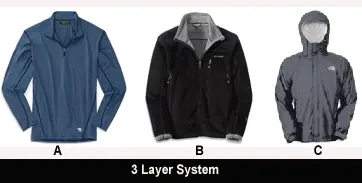Clothing For Cold Weather
There is a fantastic range of outdoor clothing for cold weather, much of it exceptionally reasonably priced if you shop around.
Several layers of clothing are best in cold conditions. Air trapped between the layers provides efficient insulation from the cold surrounding environment. Removing or adding layers regulates your temperature. See the three-layer system below:
A. The Inner Layer
The inner layer is generally thermal underwear. The inner layer should not absorb and retain moisture but transport it away from the skin, thereby countering any ‘after-exercise chill’. As manufacturers develop new high-tech synthetic fabrics or re-invent older materials like wool, the inner layer material is constantly changing. Research, and buy good quality thermals. Avoid cotton as once it is wet it stays wet, which is dangerous. Buy underwear that will last and serve the purpose.
B. The Mid Layer
This is the second clothing layer after the base layer. The Mid Layer insulates and holds body heat. The best way to do this is to create a layer of still or dead air around your body. As this still air warms, it significantly decreases any heat exchanged between your body and the ambient outside temperature. Mid Layers often consist of polyesters; have a deep pile or loft, which traps air between the fibres.
C. In the 3-Layer System
The Outer Shell is the only layer directly in contact with the chilly outside world. The Outer Shell serves three primary purposes:
1. Block wind and outside moisture like rain and snow.
2. Allow body moisture out
3. Prevent chafing, abrasion, and other damage (to your body and inner garments)
The great thing about a three-layer system is its flexibility, particularly as the outside temperature around you changes or your workload increases/decreases.
Generally, you always keep your inner layer on (except on extended trips to wash!). I have worn just the inner layer combined with a pair of shorts whilst trudging through the alpine country on a sunny day and humping a heavy pack.
The mid-layer is the one that provides the greatest flexibility in outdoor clothing for cold weather. Simply putting on and shedding layers, you can regulate your temperature according to your workload and the ambient temperature.
The outer layer is reserved for rain, snow or high wind chill conditions. As the weather and your activity change, you swap the layers.
An uncovered head radiates one-half of the body’s heat production at 4.5°C (40°F) and at -15°C (5°F). Seventy-five per cent of your total body heat can be lost. Outdoor clothing for cold weather should include balaclavas or a parka hood, as they prevent this considerable heat loss.
Remember you don’t have to be in freezing temperatures to risk hypothermia – if the environmental temperature is below your body temperature, you will “donate” heat to the surroundings. Make sure you have packed enough suitable clothing for cold weather.


